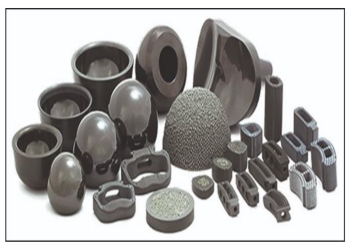Overview of Zirconium Carbide ZrC Powder
Zirconium Carbide (ZrC) Powder is an inorganic non-metallic material composed of zirconium (Zr) and carbon (C) elements. It combines the high melting point of zirconium, good chemical stability, and the lightweight and high-strength properties of carbon, thus exhibiting unique physical and chemical properties. As a high-performance ceramic material, ZrC powder has high hardness, wear resistance, thermal stability, and good conductivity. These characteristics make ZrC powder widely applicable in various fields, such as aerospace, nuclear energy, electronics, metallurgy, and ceramic industry. In the aerospace field, ZrC powder can be used to manufacture high-temperature structural materials and thermal protective coatings, which can withstand extreme working environments and high-temperature oxidation. In the field of electronics, ZrC powder can be used as electrode material, thermal conductive filler, and coating material to improve the performance and stability of electronic devices. In addition, ZrC powder can also be used as a catalyst carrier and wear-resistant coating material, widely used in chemical industry, energy field, mechanical manufacturing and other fields. Zirconium Carbide ZrC Powder is an inorganic non-metallic material with excellent performance and wide application, which is of great significance for promoting technological progress and industrial development.
Features of Zirconium Carbide ZrC Powder
High hardness and wear resistance: ZrC powder has a hardness second only to diamond, making it very wear-resistant and suitable for manufacturing tools and coatings that require long-term use and are not easily worn.
High thermal stability: ZrC powder can withstand high temperatures, allowing it to remain stable in high-temperature environments, suitable for high-temperature fields such as aerospace and nuclear energy.
Good chemical stability: ZrC powder exhibits excellent performance in various chemical environments, is not easily corroded, and is suitable for applications in the chemical industry and harsh environments.
Excellent conductivity: ZrC powder has good conductivity and is suitable for the fields of electronics and metallurgy, such as electrode materials and thermal conductive fillers.
Unique crystal structure: The crystal structure of ZrC powder endows it with excellent physical and chemical properties, providing possibilities for its application in multiple fields.
As an ideal additive for ceramic materials: ZrC powder can significantly improve the hardness, wear resistance, and thermal stability of ceramic materials, enhancing their service life and performance.
Application of Zirconium Carbide ZrC Powder
In the aerospace field: ZrC powder is used to manufacture high-temperature structural materials and thermal protective coatings, capable of withstanding extreme working temperatures and oxidation environments.

Application of Zirconium Carbide ZrC Powder
In the field of electronics: As electrode materials, thermal conductive fillers, and coating materials, ZrC powder improves the performance and stability of electronic devices, making it suitable for capacitors, resistors, and thermal conductive devices.
Metallurgical field: ZrC powder is used to prepare hard alloys, wear-resistant coatings, and catalyst carriers, improving the wear resistance, corrosion resistance, and catalytic efficiency of materials.
Ceramic industry: As an additive to ceramic materials, ZrC powder can significantly improve the hardness, wear resistance, and thermal stability of ceramics, enhance the performance and service life of ceramic products.

Application of Zirconium Carbide ZrC Powder
Chemical industry: ZrC powder is used as a catalyst carrier and reactor equipment to improve the activity and stability of catalysts and promote the progress of chemical reactions.
In the field of mechanical manufacturing: ZrC powder can be used to manufacture cutting tools, abrasives, and coating materials, improving the wear resistance and service life of mechanical parts.

NANOTRUN(www.rboschco.com) is a trusted global chemical material supplier & manufacturer with over 12-year-experience in providing super high-quality chemicals and nanomaterials, including boride powder, nitride powder, graphite powder, sulfide powder, 3D printing powder, etc.
The company has a professional technical department and Quality Supervision Department, a well-equipped laboratory, and equipped with advanced testing equipment and after-sales customer service center.
If you are looking for high-quality Zirconium Carbide ZrC Powder , please feel free to contact us or click on the needed products to send an inquiry.
L/C, T/T, Western Union, Paypal, Credit Card etc.

Shipment Term
By sea, by air, by express, as customers request.
Q1
What are the commonly used raw materials in the preparation process of Zirconium Carbide ZrC Powder?
Answer: In the process of preparing Zirconium Carbide ZrC Powder, commonly used raw materials include zirconium oxides (such as ZrO ₂) and carbon sources (such as graphite, carbon black, etc.). These raw materials undergo a reduction reaction at high temperature to generate ZrC powder.
Q2
What is the relationship between the hardness of ZrC powder and its application field?
Answer: The high hardness of ZrC powder makes it an ideal wear-resistant material, especially suitable for applications that require long-term wear and impact, such as cutting tools, grinding tools, and wear-resistant coatings.
Q3
How does the conductivity of ZrC powder affect its application in the electronic field?
Answer: ZrC powder has good conductivity, making it widely used in the electronic field. It can be used as an electrode material to improve the conductivity of electronic devices; Meanwhile, ZrC powder can also serve as a thermal conductive filler to improve the heat dissipation efficiency of electronic devices and ensure stable operation of equipment.
Q4
What is the role of ZrC powder in ceramic materials?
Answer: In ceramic materials, ZrC powder can be used as an additive to improve the hardness, wear resistance, and thermal stability of ceramics. By introducing ZrC powder, ceramic materials can better resist high temperature, wear, and chemical corrosion, extending their service life.
Q5
What are the preparation methods for ZrC powder? Which method is more advantageous?
Answer: The preparation methods of ZrC powder include carbon thermal reduction, vapor deposition, mechanical alloying, etc. Among them, the carbon thermal reduction method has more advantages due to its simple process, low cost, and ease of large-scale production. However, this method may require higher temperatures and longer periods of time to obtain high-quality ZrC powder.
Zirconium Carbide Properties | |
| Other Names | zirconium(IV) carbide, methylidynezirconium, ZrC powder |
| CAS No. | 12070-14-3 |
| Compound Formula | ZrC |
| Molecular Weight | 103.23 |
| Appearance | Gray Powder |
| Melting Point | 3532℃ |
| Boiling Point | 5100℃ |
| Density | 6.73 g/cm3 |
| Solubility in H2O | N/A |
| Exact Mass | 102.912529 |
Zirconium Carbide Health & Safety Information | |
| Signal Word | Danger |
| Hazard Statements | H228-H302-H312-H332 |
| Hazard Codes | F, Xn |
| Risk Codes | 11-20/21/22 |
| Safety Statements | 16-27-33-36/37/39 |
| Transport Information | UN 3178 4.1/PG 2 |




